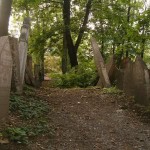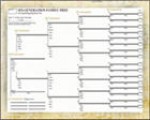Search results
Genealogy Trees | The Role of Cemeteries
December 31, 2008 by Chris
Filed under Articles, Cemetery Searches, Genealogy Cemetery Searches, Genealogy Records 101
 As regular readers of this site you know I’m a big fan of making sure cemetery research is a method used for researching your genealogy and family trees. Below is an example from Southern Graves (see link below for original post) on how we can find our past generations using cemetery search methods.
As regular readers of this site you know I’m a big fan of making sure cemetery research is a method used for researching your genealogy and family trees. Below is an example from Southern Graves (see link below for original post) on how we can find our past generations using cemetery search methods.
The author of the original post writes…
Mrs. Eliza B. R. Mendenhall died almost 160 years ago on December 29, 1848. She was 67 years of age at the time of her death, so her birth year was about 1781. She, along with her infant grandson John Bruce Limehouse, was interred in St. Philip’s Church Cemetery; Charleston, South Carolina.
I love the wording on this stone. In case you cannot read it via the photo, here is a transcription:
This marble marks the spot where repose
the remains of
Mrs. Eliza B. R. Mendenhall,
Who closed her earthly career on the 29th December A.D. 1848,
aged 67 years.
By her side sleeps her infant
grandson
John Bruce Limehouse.
“Thou art gone to the grave, but we will
not deplore thee
whose God was thy ransom, they Guardian
and Guide.
He gave thee, He took thee
and He will restore thee,
and death has no sting for the
Savior hath died.”
This stone is consecrated
to a beloved mother
by her daughter.
(This posting is from Southern Graves. Click the link to view the full article from its original source.)
As you can see from the transcription, there is a wealth of information to help us complete our family trees. Grave stones typically contain extensive records of birth and death dates. They also often cite family members.
By doing the math on age and date of death you can get the date of birth. While not cited here, you sometimes can discover where someone lived from a grave stone as well, which can lead to a local government office and a copy of a birth certificate (which, as you know, will reveal the parents and thus the next generation.)
Don’t overlook cemeteries in our work to build out your genealogy trees. They will save you a ton of time.
…
Where to Next?
Blank Family Tree with Step-by-Step Instructions
…
How To Make Family Tree
November 16, 2008 by Chris
Filed under Blank Family Tree
 There can be a lot of confusion the fist time you’re trying to figure out how to make a family tree. There are so many sites, resources, templates, and so-called experts that you’re left wondering which way is up. This short article is designed to provide you with a few simple steps that will allow you to get started so you know exactly how to make a family tree. First you need a blank family tree template. You can get one for free at the www.genealogybeginner.com website. Once you download your blank family tree template you’ll need to complete it for yourself and your parents.
There can be a lot of confusion the fist time you’re trying to figure out how to make a family tree. There are so many sites, resources, templates, and so-called experts that you’re left wondering which way is up. This short article is designed to provide you with a few simple steps that will allow you to get started so you know exactly how to make a family tree. First you need a blank family tree template. You can get one for free at the www.genealogybeginner.com website. Once you download your blank family tree template you’ll need to complete it for yourself and your parents.
Just start here. It can be as simple as digging out your own birth certificate and (if appropriate) your marriage certificate, writing do the dates on the blank family tree template, and filing away our certificate copies.
Next you do the same for your parents. You’ll likely need to speak with them about their own parents and to ask for original copies of their birth and marriage certificate so you can make copies and add them to your records.
And that is really what building a family tree is all about. The trick to how to make a family tree is not all that hard (but can be frustrating if you don’t have the basics). It’s a process of identifying the three primary certificates for each of your ancestors (Birth Certificate, Marriage Certificate, and Death Certificate), obtaining copies, and then making notes about who leads to who on a family tree.
Now your family tree search doesn’t need to be limited to just this. While these are the core tasks there is a wealth of other items you can work on and develop to make your tree even richer.
For example, you’ll want to collect any family artifacts you come across like:
- Photos
- Deeds
- Court filings
- Estate records
As well as anything “official” that marks the existence of your family. Some folks make a point to take photos of grave stones or even do gravestone etchings to add to their tree.
With all of these materials in place, you have the basis for a great scrapbook or similar type family heirloom that can be passed down for generations to come. Get an artistic rendering of your official family coat of arms (if you have one), put it on the cover, and you have a wonderful book that defines your legacy.
You see, learning how to make a family tree doesn’t need to be complicated or overly confusing. It simply takes a little understanding of the basics and the will to figure it all out. Check out the resources below if you need a little more assistance:
- Download a Blank Family Tree Template
- Download instructions on How to Complete a Family Tree
- Download a Step-by-Step Genealogy Guide to get you started with your online research.
A Family Tree Search Sunday
February 12, 2008 by Chris
Filed under Articles, Blank Family Tree, Latest News
 This is a neat idea that more communities should consider. What better way to show residents how their tax dollars work than a family tree search Sunday. This story from the Scarborough Evening News reports that residents of Scarborough will be welcome to participate in a unique event every Sunday. It is a day set aside to help research their family trees. The Council Records Office in North Yorkshire County is taking registrations for a family history “day school” intended to aid beginning genealogists in their initial research.
This is a neat idea that more communities should consider. What better way to show residents how their tax dollars work than a family tree search Sunday. This story from the Scarborough Evening News reports that residents of Scarborough will be welcome to participate in a unique event every Sunday. It is a day set aside to help research their family trees. The Council Records Office in North Yorkshire County is taking registrations for a family history “day school” intended to aid beginning genealogists in their initial research.
The Sunday sessions will provide access to parish and non conformist records as well as give lessons on how to use census and registration records. The study days will be headed by Jackie Depelle, a local history tutor and Records Office staff will be on hand to assist participants.
Read the full article …
Too bad it isn’t a bit closer to home.
…
Where to Next?
…
